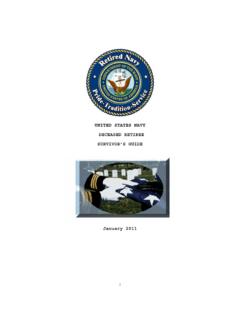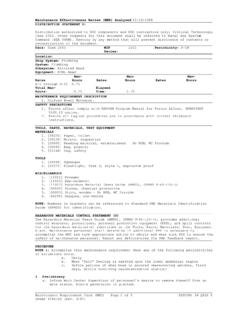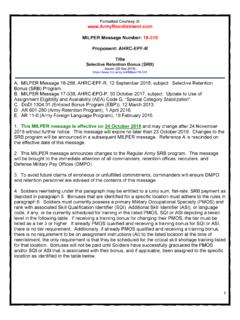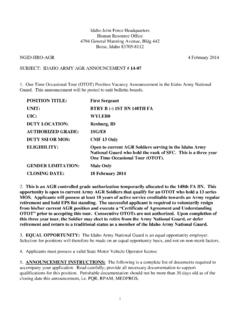Transcription of NAVPERS 15878J (Rev 10-03)
1 NAVPERS 15878J (Rev 10-03) NAVY CAREER INFORMATION PROGRAM 1. The primary goal of the Navy Career Information Program is to ensure each Sailor both active and reserve, wherever stationed, be provided with a sufficient quantity and quality of career information, in a timely manner, to allow them to make sound career decisions. 2. While this program forms the foundation of a successful program, its true success rest on the commitment of the chain of command. The chain of command must ensure every sailor is provided the guidance and opportunity to succeed. J. W. TOWNES, III Rear Admiral, Navy Deputy Chief of Naval Personnel PREFACE CAREER INFORMATION MANAGEMENT 1. Career Information Management (CIM) provides the basis for establishing and managing a Command Career Development Program.
2 CIM provides Command Career Counselors (CCC) with program management techniques. It sets guidelines for a successful retention program and defines required Career Development Team (CDT) training. CIM is designed specifically to engage the entire chain of command in the career development of our best Sailors. 2. The Career Counselor Handbook identifies the following elements as the foundation to a successful command career management program: a. Career Development Team. b. Command Career Development Program Management. c. Command Sponsor and Indoctrination Program. d. Career Development Board. e. Navigational Tracks. f. Program Review. g. Naval Reserve Information. 3. These programs are a first step in complying with the CNO directive that no Sailor will be left behind.
3 The success of this program rest on the chain of commands commitment and continued involvement once the foundations are in place. TABLE OF CONTENTS title Page CHAPTER I Career Development Team I-1 Career Development Team Building I-1 Department/Division Collateral Duty Career I-2 Counselor Career Development Team Meetings I-3 Components of a CDT Meeting I-4 The Successful Program I-5 Department/Division Reports I-5 CHAPTER II Training II-1 Purpose II-1 Discussion II-1 CDT Training II-1 Navy Counselors II-2 CHAPTER III Career Development Program (CDP) Management III-1 CCC s Primary Responsibility III-1 CDP III-1 Office Organization III-2 Retention Statistics and Reports III-3 Computing Statistics III-3 Program Success III-4 CHAPTER IV Career Development Board (CDB) IV-1 Purpose IV-1 Discussion IV-1 Board Composition IV-1 Career Development Board Discussion Topics IV-1 CCC/Department Career Counselor IV-1 Responsibilities Education Service Officer (ESO) IV-2 Department/Division LCPO/LPO IV-2 Command CDB IV-2 Department Career Development Board IV-3 Career Development Board Procedures IV-3 Career Development Plan IV-4 Career Development Board Guidance IV-8 i title Page CHAPTER V Command Sponsor and Indoctrination Program V-1 Sponsor and Indoctrination Program V-1 Sponsor Program V-1 Indoctrination Program V-4 CHAPTER VI Navigational Tracks VI-1 Timelines VI-1 Perform to Serve (PTS)
4 VI-1 Team Detailing VI-2 Perform to Serve/Team Detailing Timeline VI-3 Transition Counseling and Assistance VI-5 Timeline CHAPTER VII Command Program Review VII-1 Purpose VII-1 Conducting and Briefing a Program Review VII-1 CHAPTER VIII Naval Reserve Force VIII-1 Naval Reserve Mission VIII-1 Naval Reserve Force VIII-1 Naval Reserve Procedures Directives VIII-1 Naval Reserve Benefits VIII-1 Naval Reserve Participation VIII-4 Promotions/Advancements VIII-5 Retirement VIII-5 Mobilization VIII-9 TAR Enlistment Program (TEP) VIII-10 Naval Reserve Terminology VIII-11 Naval Reserve Status Chart VIII-17 Naval Reserve Affiliation Timeline VIII-18 Appendices A Periodic Retention/Career Development Report B Individual Career Development Plans C Command Career Development Program Review ii CHAPTER I CAREER DEVELOPMENT TEAM 1.
5 Career Development Team (CDT) Building. Underlying the entire program is the building of an effective CDT. A well-organized CDT engages the entire chain of command and provides a means to guarantee continuity in career development efforts and individual professional growth encompassing all five vectors within the Sailor Continuum. An effective CDT is the key ingredient of a successful career development program. Properly organized, efficient CDTs directly reflect the support of the organization and everyone in the chain of command. Active involvement of the chain of command from the top down is the key element to a successful Career Development Program (CDP) and provides the guidance each Sailor needs to meet the objectives of all five vectors. a. Far too many commands have structured their CDT to rely too heavily upon the Command Career Counselor (CCC) to provide the majority of all services relating to career development.
6 This frequently leads the command to adopt a one-to-one counseling philosophy that demands the CCC personally contact all members of the command whenever career development-related matters are involved. b. Building an entire program around a single individual (or relatively few individuals) has serious drawbacks because the absence of the key person (permanently or temporarily) ends the program. The organization must then be restructured around the personality and capabilities of the replacement individual. This results in a constantly changing program that is not understandable by the Sailors it is designed to serve, nor does it function continuously at a high level of efficiency. c. By organizing a command-wide CDT, the CCC assumes a totally different role, that of CDP manager.
7 As such, the CCC s responsibilities include management, training, administration of the CDP, internal public relations, and other facets of the CDP. Obviously, as an overall manager, one-on-one counseling becomes a smaller part of the CCC s job. The key to success is the delegation of responsibility for counseling to the appropriate team members. d. To make the process work, the chain of command must assume responsibility for conducting routine training. The I-1 minimum career information training required is the Career Development Training Course (CDTC). e. Proper organization of counseling activities provides the following benefits: (1) Increased credibility of the chain of command. (2) A progressive increase in the counseling expertise of supervisory personnel. (3) A lower client-to-counselor ratio through the use of all available command assets.
8 (4) Better-informed Sailors at all command levels. (5) More time for CCCs to manage the program and counsel individual cases that require their expertise and experience. (6) Increased program effectiveness through teamwork. f. The composition of the CDT should include, but is not limited to (1) commanding Officer (CO). (2) executive Officer (XO). (3) command master chief/chief of the boat (CMC/COB). (4) command career counselor (CCC). (5) department heads. (6) division officers. (7) leading chief petty officers. (8) department or division career : OPNAVINST provides retention team scope of responsibilities. 2. Department/Division Collateral Duty Career Counselors. Collateral duty career counselors should be selected based on their ability to be effective communicators and mentors.
9 Great I-2 care must be taken in the selection of Sailors to fill these key positions. Commands must avoid assigning Sailors a. whose other responsibilities are too demanding. b. without regard to division size or mission, more than one counselor is often necessary. 3. Career Development Team Meetings a. CDT meetings are critical to the success of the program. Meetings provide rapid distribution of information, information exchange, problem solving, decision-making, etc. A meeting can be an occasion where a group s collective knowledge is revised, updated, and increased. A successful meeting creates a commitment to group decisions and goals on the part of each person attending. Often, a meeting is the only occasion where all the individuals work as a collective body.
10 B. Monthly department and division career counselor meetings are central to the program. These meetings keep the team up-to-date on program and policy changes and allow continuous monitoring of Sailors professional development. The meetings will be scheduled via Planning Board for Training (PBFT) or the command s alternative scheduling vehicle. At a minimum, the following items will be on each meeting s agenda: (1) Review of team detailing spreadsheet, Perform to Serve (PTS), applications, transition, and reserve affiliation timelines. (2) Review results of all CDBs from the previous month to determine actions required and actions completed. (3) Discuss all career development related actions still pending. (4) Discuss new programs and policies. c. To effectively manage the career development of Sailors, command leadership must hold all CDT members accountable.









